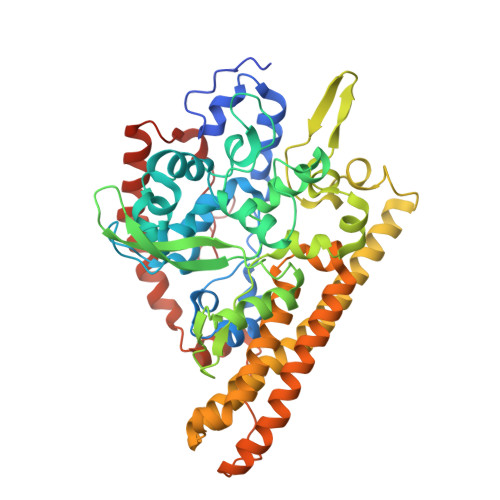Binding and Reduction of Sulfite by Cytochrome c Nitrite Reductase
Lukat, P., Rudolf, M., Stach, P., Messerschmidt, A., Kroneck, P.M.H., Simon, J., Einsle, O.(2008) Biochemistry 47: 2080-2086
- PubMed: 18201106
- DOI: https://doi.org/10.1021/bi7021415
- Primary Citation of Related Structures:
3BNF, 3BNG, 3BNH, 3BNJ - PubMed Abstract:
Pentaheme cytochrome c nitrite reductase (ccNiR) catalyzes the six-electron reduction of nitrite to ammonia as the final step in the dissimilatory pathway of nitrate ammonification. It has also been shown to reduce sulfite to sulfide, thus forming the only known link between the biogeochemical cycles of nitrogen and of sulfur. We have found the sulfite reductase activity of ccNiR from Wolinella succinogenes to be significantly smaller than its nitrite reductase activity but still several times higher than the one described for dissimilatory, siroheme-containing sulfite reductases. To compare the sulfite reductase activity of ccNiR with our previous data on nitrite reduction, we determined the binding mode of sulfite to the catalytic heme center of ccNiR from W. succinogenes at a resolution of 1.7 A. Sulfite and nitrite both provide a pair of electrons to form the coordinative bond to the Fe(III) active site of the enzyme, and the oxygen atoms of sulfite are found to interact with the three active site protein residues conserved within the enzyme family. Furthermore, we have characterized the active site variant Y218F of ccNiR that exhibited an almost complete loss of nitrite reductase activity, while sulfite reduction remained unaffected. These data provide a first direct insight into the role of the first sphere of protein ligands at the active site in ccNiR catalysis.
Organizational Affiliation:
Institut für Mikrobiologie und Genetik, Abteilung Molekulare Strukturbiologie, Georg-August-Universität Göttingen, 37077 Göttingen, Germany.



















